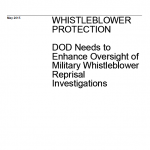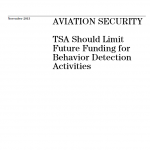
The Department of Defense (DOD) did not meet statutory military whistleblower reprisal 180-day notification requirements in about half of reprisal investigations closed in fiscal year 2013, and DOD’s average investigation time for closed cases in fiscal years 2013 and 2014 was 526 days, almost three times DOD’s internal 180-day requirement. In 2012, GAO made recommendations to improve investigation timeliness, and DOD has taken some actions to address those recommendations. However, based on a random sample of 124 cases, GAO estimated that there was no evidence that DOD sent the required notification letters in about 47 percent of the cases that DOD took longer than 180 days to close in fiscal year 2013. For cases in which DOD sent the required letter, GAO estimated that the median notification time was about 353 days after the servicemember filed the complaint, and on average the letters significantly underestimated the expected investigation completion date. DOD does not have a tool, such as an automated alert, to help ensure compliance with the statutory notification requirement to provide letters by 180 days informing servicemembers about delays in investigations. Without a tool for DOD to ensure that servicemembers receive reliable, accurate, and timely information about their investigations, servicemembers may be discouraged from reporting wrongdoing.

